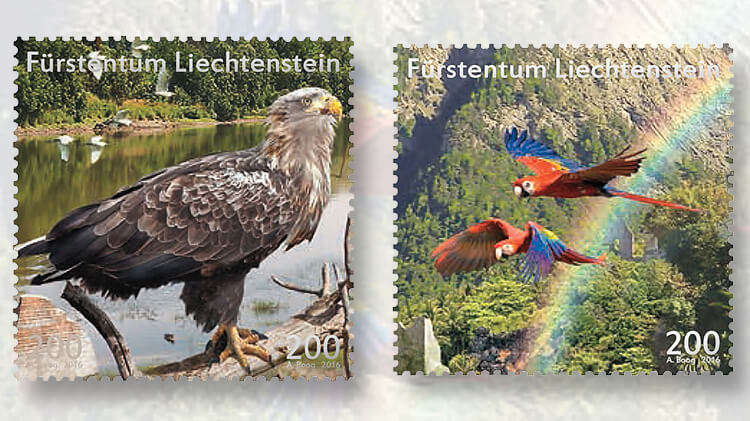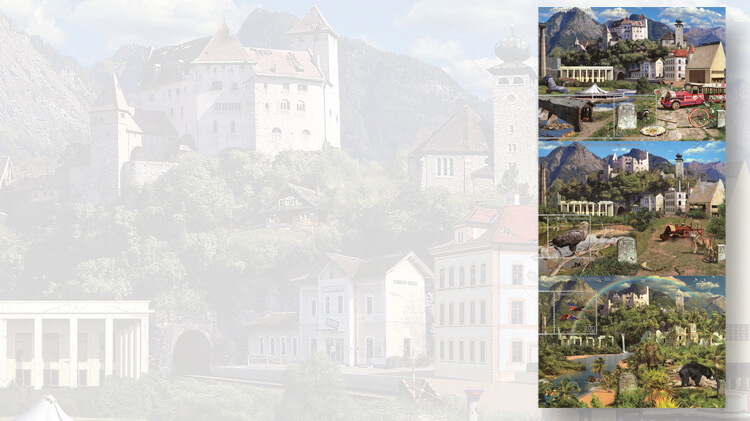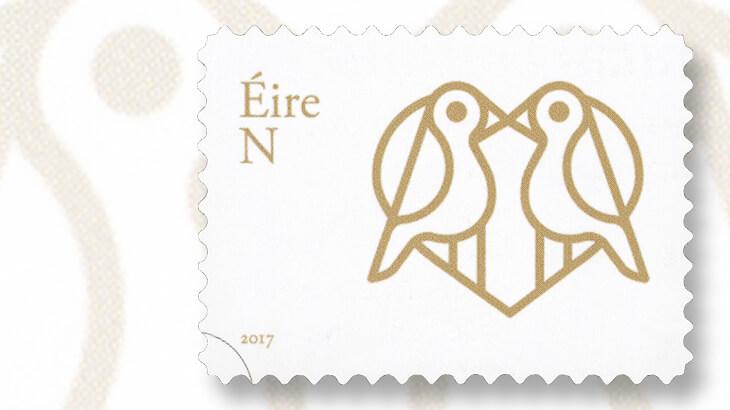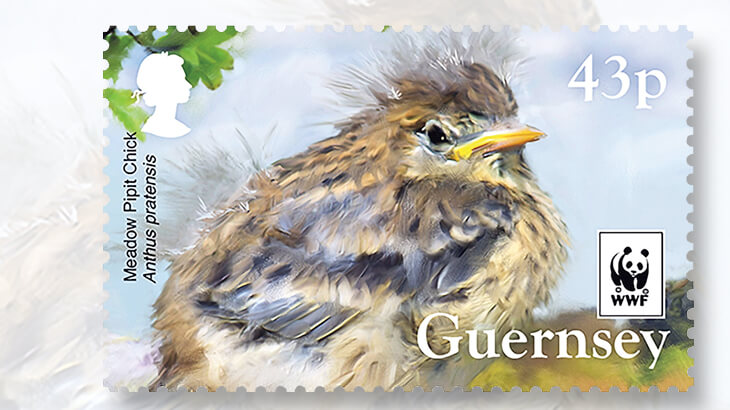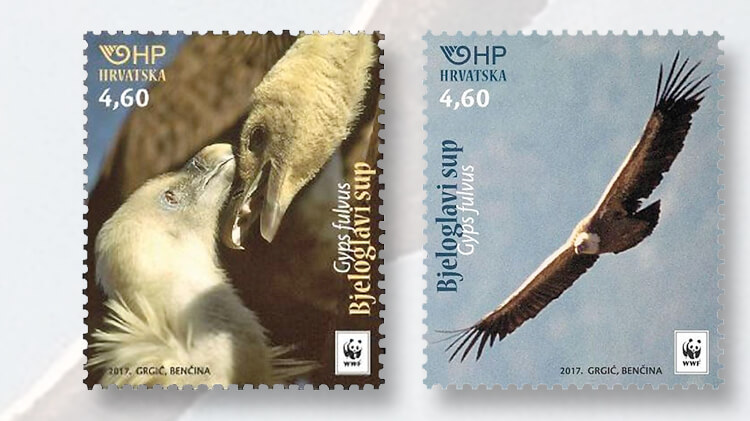World Stamps
Majestic birds of prey, lovebirds and more take wing on new stamps
By Denise McCarty
In conjunction with the year of the rooster, many stamps this year will depict roosters. Several other types of birds will be shown as well.
Norway started the year by issuing two coil stamps Jan. 2 in its Birds definitive series.
The two 20-krone stamps pictures birds of prey, the merlin (Falco columbarius) and the Eurasian hobby (Falco subbuteo). Both birds are small, known for their rapid flight and their ability to catch their prey in the air.
Connect with Linn’s Stamp News:
Sign up for our newsletter
Like us on Facebook
Follow us on Twitter
The merlin received the nickname “lady hawk” because noblewomen in medival Europe used it in falconry.
The Eurasian hobby has a wide range, including Europe, Asia and northern Africa. In Norway, it is found in the southeastern part of the country, particulary Hedmark.
Viggo Ree created the illustrations for the stamps. Enzo Finger designed them, and Joh. Enschede of the Netherlands printed them by offset.
Also in January, St. Pierre and Miquelon added a stamp showing the common yellowthroat (Geothlypis trichas) to its Birds series, and St. Martin continued its series with a pane of nine picturing different species (Mergus octocetaceus, Phaetusa simplex, Phimosus infuscatus, Podiceps major, Puffinus puffinus, Rynchops niger, Sarcoramphus papa, Sterna maxima, and Theristicus caudatus).
Croatia and Guernsey
New bird stamps from Croatia and Guernsey include the panda emblem of the World Wildlife Fund, an international conservation organization.
The first stamps with the WWF emblem were issued in 1983, and since then more than 200 postal administrations have issued stamps displaying the emblem.
The four Croatian stamps issued Jan. 23 highlight the Eurasian griffon (Gypus fulvus), also called the griffon vulture.
Croatia’s Hrvatska Posta describes this scavenger as “one of the most fascinating and biggest birds that fly,” adding that it can weigh up to 14 kilograms (30 pounds) with a wing span up to 2.80 meters (9 feet).
The new-issue announcement also said that while a century ago the Eurasian griffon could be found throught much of Croatia, today fewer than 100 pairs inhabit an area if the Kvarner Gulf on the northern Adriatic Sea.
The stamps are se-tenant (side-by-side) in panes of 16. Each stamp is denominated 4.60 kune.
The designs are based on photographs by Hrvoje Grgic. AKD in Zagreb printed the stamps by offset.
Guernsey will issue four stamps Feb. 15 featuring the meadow pipit (Anthus pratensis).
While this small yellow-brown songbird is more common elsewhere, in the Bailiwick of Guernsey it is classified as an endangered species.
According to the new-issue announcement from Guernsey Post, there may be fewer the 100 breeding pairs on Guernsey and Herm, adding that there is a similar decline on Alderney.
The stamps are denominated 43 pence, 57p, 64p and 70p. They were designed by Andrew Robinson and printed by Cartor using offset lithography in panes of 10.
Ireland
Ireland’s latest Love and Marriage stamp features symbolic love birds.
The stamp was issued Feb. 2 in time for use on Valentine greetings, as well as wedding invitations throughout the year. It is nondenominated with an “N,” indicating that it pays the basic national rate.
The firm Zero-G designed the stamp. In An Post’s new-issue bulletin The Collector, the design is described as featuring an illustration in gold “of a love heart surrounding the two lovebirds kissing.”
The bulletin also said: “While the term ‘lovebirds’ is regularly used to describe an openly affectionate couple, in reality the lovebird is a very small African and Madagascan parrot with mainly green plumage and usually a red, peach or black face. What makes them so unusual is the affectionate behaviour of mated birds.”
Cartor printed the stamps by offset-lithography in booklets of 10.
Liechtenstein
Birds are pictured on two of the three stamps in a recent Liechtenstein issue with the premise “What would happen to Liechtenstein if there were no more people?”
The three 2-franc stamps were issued Nov. 14, 2016, in what Liechtenstein’s philatelic bureau calls a “three-part souvenir sheet,” meaning that all three sheets are combined in one unit.
In creating the illustrations that appear on the stamps and souvenir sheets, Swiss artist Angelo Boog was inspired by the 2007 nonfiction besteller The World Without Us by Alan Weisman.
The philatelic bureau described Boog’s designs as collages that show buildings, monuments, objects, and landscapes from an “imagined future devoid of human beings” in 20, 100, and 500 years from now.
The top souvenir sheet contains a single stamp showing a badger. A bald eagle is pictured on the stamp in the center souvenir sheet, and a pair of parrots and a rainbow on the stamp in the final sheet.
Joh. Enschede printed the issue by offset and silver hot-foil stamping.
MORE RELATED ARTICLES
Headlines
-
US Stamps
Oct 7, 2024, 3 PMMcMurtrie dismissed as APS education director following Sept. 21 arrest
-
US Stamps
Oct 7, 2024, 12 PMVasiliauskas named president of Mystic Stamp Co.
-
US Stamps
Oct 6, 2024, 5 PMApgar souvenir card available
-
US Stamps
Oct 6, 2024, 4 PMFirst Continental Congress and U.N. stamps receive Scott catalog numbers

